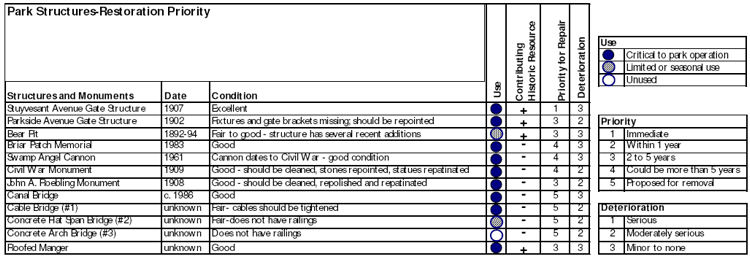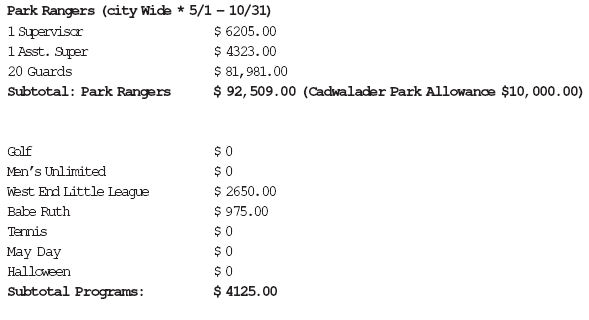| Top | Master Plan Contents |
Appendix
A/B Olmsted Firm Planting Lists for Cadwalader Park
C Stormwater Structures & Park Utilities
D Existing Buildings and Structures: Park Buildings–Restoration Priority
E Existing Buildings and Structures: Park Structures–Restoration Priority/Recreation Facilities
F Summary of Cadwalader Park Master Plan Survey
G Water Quality Test Results for West Ravine Ponds and Stream
H Recreation Budget for Cadwalader Park
| Top | Master Plan Contents |
APPENDIX - A/B Olmsted Firm Planting Lists for Cadwalader Park
Trees and shrubs ordered by Olmsted firm for planting in Cadwalader Park boundary areas- Fall 1891
| Botanical Name [Common name] | Qty | Size | Cost |
| Acer platanoides [Norway maple] | 200 | 3 yrs | $16 |
| Acer platanoides [Norway maple] |
200 | 3 yrs | $16 |
| Acer spicatum (mountain maple) |
1000 | 15 | |
| Berberis vulgaris [Common barberry] |
1000 | 3yrs | 30 |
| Betularubra[B. nigra, Riverbirch] |
100 | 2-3' | 3 |
| Betula papyraceae (American canoe birch) |
100 | 3-5' | 2 |
| Blackberry Kittatinny [Agawan substituted] |
1000 | 10 | |
| Carya alba [C. ovata, Shagbark hickory] |
100 | 12-18" | 5 |
| Catalpa speciosa [Western catalpa] | 100 | 15-24" | 1.50 |
| Crataegus crus-galli [Cockspur hawthorn] |
200 | 18-24" | 16 |
| Crataegus oxycanthus
[C. laevigata, Englishhawthorn] |
1000 | 12-20" | 5 |
| Fagus americana
[F. grandifolia, Americanbeech] |
100 | 2-3' | 2.50 |
| Fraxinus americana [White ash] | 100 | 1-2' | .75 |
| Fraxinusviridis [F. pennsylvanica, Redash] |
2500 | 3-4' | 12.50 |
| Gooseberry Houghtons |
500 | 2yrs | 10 |
| Gymnocladus canadensis
[G. dioica, Kentucky coffee tree] |
100 | 18-24" | 10 |
| Hypericum prolificum
[Shrubby St. John’s Wort] |
1000 | 12 | |
| Laurussassafras[Sassafras] |
200 | 12-18" | 10 |
| Liquidambar styraciflua [Sweet gum] |
200 | 4-5' | 20 |
| Liriodendrontulipifera[Tuliptree] |
500 | 2-3' | 10 |
| Lucretia mammoth [?] |
1000 | 10 | |
| Lycium barbarum (vulgare) [Matrimony vine] |
1000 | 12 | |
| Maclura auriantiaca
[M. pomifera, Osage orange] |
2500 | 12.50 | |
| Magnolia macrophylla [Great-leaved magnolia] |
50 | 12-18" | 5 |
| Magnolia acuminata [Cucumber tree] |
500 | 15-24" | 15 |
| Magnoliatripetala[Umbrella-tree] |
50 | 10-18" | 2 |
| Morus alba [White mulberry] | 500 | 2-3' | 10 |
| Negundo aceroides [Acer negundo, Box elder] |
1000 | 2-3' | 3.50 |
| Nyssa multiflora [N. sylvatica, Tupelo] |
100 | 12-18" | 3.50 |
| Plum, Mariana stock |
1000 | Extra | 12.50 |
| Populus monilifera
[P. deltoides, Cottonwood] |
500 | 6-10' | 30 |
| Potentillafruticosa[Shrubbycinquefoil] |
1000 | 12 | |
| Prunus mahaleb [St. Lucie cherry] |
1000 | 18-24" | 20 |
| Pteleatrifoliata[Waterash] |
50 | 2-3' | 3.75 |
| Pyrus myrocobolana (Pear) |
500 | 20 | |
| Quercus macrocarpa [Bur oak] |
50 | 4-5' | 5 |
| Quercus coccinea [Scarlet oak] |
200 | 2-3' | 10 |
| Quercus castanea
[Q. Muehlenbergii, Chestnut oak] |
200 | 18-24" | 10 |
| Rosa carolina [Pasture rose] |
1000 | 8.50 | |
| Rosa blanda |
500 | 8.50 | |
| Sambucus canadensis [American elderberry] |
1000 | 18 | |
| Tilia americana [Basswood] |
50 | 3-5' | 5 |
| Xanthoxylum americanum [Prickly ash] |
2000 | 30 | |
| Yellow cottonwood [no botanical name noted] | 2500 | 3-5' | 12.50 |
Plant materials ordered by Olmsted firm in April 1892 for interior area of Cadwalader Park
| Botanical Name [Common name] | Qty | Size | Cost |
| Acer campestris [Field maple] |
20 | 9-10' | $4.00 |
| Acer colchicum |
15 | 4-6’tr. | 1.95 |
| Acer colchicum |
13 | 4-5' | 3.25 |
| Acer negundo [Box elder] |
05 | 12-14' | 1.50 |
| Acer platanoides [Norway maple] |
12 | 10-12' | 9.00 |
| Acer rubrum [Red maple] |
18 | 10-11' | 7.20 |
| Acer saccharinum [Silver maple] |
59 | 12-14' | 53.10 |
| Acer tataricum [Tartarian maple] |
24 | 5-6' | 8.00 |
| Aesculus glabra [Ohio buckeye] |
12 | 10-12' | 6.00 |
| Asimina triloba [Pawpaw] |
8 | 3-5' | 1.60 |
| Betulalenta[Blackbirch] |
02 | 10-12' | 1.00 |
| Bignonia grandiflora [Trumpet-vine] |
04 | 1.66 | |
| Carpinus betulus [European hornbeam] |
10 | 6-8' | 2.50 |
| Catalpa speciosa [Western catalpa] |
12 | 12-16' | 4.80 |
| Cercis canadensis [Redbud] |
24 | 4-5' | 6.00 |
| Cornus alternifolia [Pagoda dogwood] 7.00 |
35 | 2-3' | 7.00 |
| Cornus florida [Flowering dogwood] |
15 | 6-7' | 15 |
| Cornus florida |
25 | 6-8' | 6.25 |
| Crataegus crus-galli [Cockspur hawthorn] | 02 | 1.5-2' | 20ar |
| Fagus amercanus [F. grandifolia, American Beech] | 10 | 5-6' | 2.50 |
| Fagus sylvatica [European Beech] | 17 | 6-8' | 4.25 |
| Hedera hibernica [H. helix. var. hibernica, Irish Ivy] | 50 | 6.00 | |
| Hedera hibernica | 50 | 3 YR | 5.00 |
| Koelreuteria panaculata [Varnish Tree] | 03 | 10-12' | 1.50 |
| Liquidambar styraciflua [Sweet Gum] | 18 | 5-6'tr | 4.50 |
| Liquidambar styraciflua | 18 | 10' | 18 |
| Magnolia acuminata [Cucumber-tree] | 5 | 6-7' | 2.00 |
| Ostrya virginiana [American hop hornbeam] | 07 | 3-4'tr | 1.05 |
| Philodendron Amurense [Araceae] | 06 | 5-7' | 2.00 |
| Pyrus baccata (Malus Parkmanii) [Malus baccata, Siberian crabapple] | 06 | 5-6' | 5.50 |
| Quercus alba [White oak] | 8 | 6-8' | 6.66 |
| Quercus bicolor [Swamp white oak] | 03 | 10-12'tr. | 2.25 |
| Quercus coccinea [Scarlet oak] | 04 | 8-10' | 4.00 |
| Scarlet Oak | 4 | 4-5' | .80 |
| Quercus macrocarpa [Bur oak] | 03 | 12-14' | 1.35 |
| Quercus palustris [Spanish oak] | 03 | 10-12' | 2.25 |
| Quercus phellos [Willow oak] | 01 | 9-10' | 0.40 |
| Ulmus Americana [American elm | 56 | 9-12' | 22.40 |
| Ulmus campestris [U. Procera, English elm] | 15 | 9-12' | 4.50 |
| Ulmus fulva [U. rubra, Slippery elm] | 20 | 7-9'tr. | 7.00 |
| Ulmus racemosa [U. thomasii, Rock elm] | 07 | 2-3' | 1.05 |
| Top | Master Plan Contents |
APPENDIX C - Stormwater Structures & Park Utilities
Stormwater

Utilities

Note: Based on Utilities Mapping by Parsons Brinckerhoff-FG, Inc.
Cadwalader Park Archive
| Top | Master Plan Contents |
APPENDIX D - Existing Buildings and Structures: Park Buildings–Restoration Priority

| Top | Master Plan Contents |
APPENDIX E - Existing Buildings and Structures: Park Structures–Restoration Priority/Recreation Facilities


| Top | Master Plan Contents |
APPENDIX F - Summary of Cadwalader Park Master Plan Survey (June 24, 1998)
A brief survey form was distributed to all participants attending the 24 June 1998 public meeting to discuss the Cadwalader Park Master Plan. Participants were asked to fill out the form and return it before leaving the meeting. With one exception (“How often do you come to Cadwalader Park?”), all questions were open-ended, allowing for a full range of responses.
A total of 70 persons signed in at the public meeting. Of these, 43 handed in completed survey forms. This represents a 61 percent response rate, which is considered very good. A compilation of the responses is provided on the attached pages. (Please note that the total number of responses to each question often exceeds 43 since many respondents gave multiple answers to several items.) A summary of the most frequent responses is provided below.
1. Why do you come to Cadwalader Park (what activities do
you typically do there)?
The three most frequent responses indicated that people come to the Park to walk (which includes walking their dogs), to relax and have fun, and to visit Ellarslie.
2. How often do you come to Cadwalader Park?
Responses indicated that those attending the meeting were frequent visitors to the Park. The greatest number of respondents said they came to the Park on a daily basis, with the next largest number saying they visited about once a week.
3. What features and qualities of the Park do you feel it will be important for the Master Plan to keep?
The elements to be retained that were most often mentioned included the deer, the continuation of limited vehicular access, Ellarslie, a playground (although one that is upgraded), and the picturesque landscape with its lovely trees.
4. What things about the Park do you feel could be different?
The responses cited most often included opening the entire park to the public (probably in response to the decision to close some of its entrances), upgrading the landscape, and improving park maintenance.
5. Are there any additional activities or events that you would like to see take place in Cadwalader Park in the future?
Participants most frequently mentioned wanting to see more performances in the Park (concerts, theater, etc.), other community-wide events, and improved facilities for children.
6. If you live in Trenton, what neighborhood do you live in? If you live outside of Trenton, what community do you live in?
Most respondents came from the West Ward (including Hiltonia and Cadwalader Heights), but many other areas of the city and its surroundings were represented.
| Top | Master Plan Contents |
APPENDIX G - Water Quality Test Results for West Ravine Ponds and Stream
Results of the water quality testing have confirmed high levels of fecal coliform and fecal streptococcus bacterian in the stream that runs through the paddock (test results attached). The acceptable limit for fecal coliform bacteria for human contact in water is 200. The bacteria count for this stream is over 100 times the limit above the deer paddock, and 300 times the limit below the paddock. The testing service has recommended that the bacteria tests be repeated on other days to reduce the possibility that a storm flush may have increased the level of contaminants. The animals are clearly the major contributor to the high bacteria count, however the level above the deer paddock is unacceptably high as well. The State Department of Environmental Protection will probably want the City to investigate the source of the upstream pollution before developing any plans that give people greater access to the streams and lakes. |
All results in mg/l (ppm) except where noted. Laboratory ID No. 11198 |
| Top | Master Plan Contents |
APPENDIX H - Recreation Budget for Cadwalader Park

